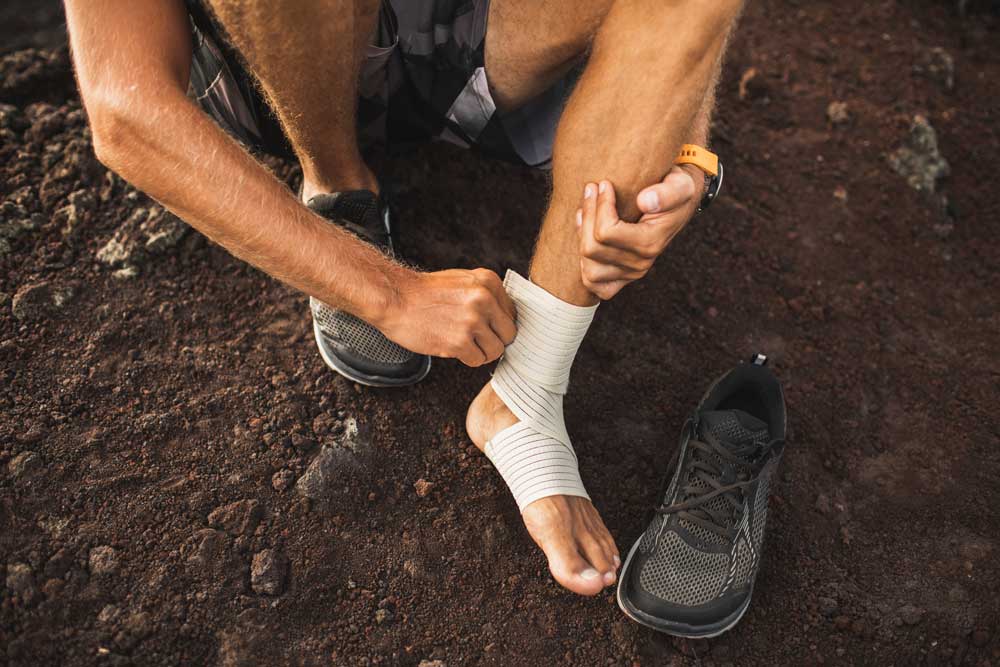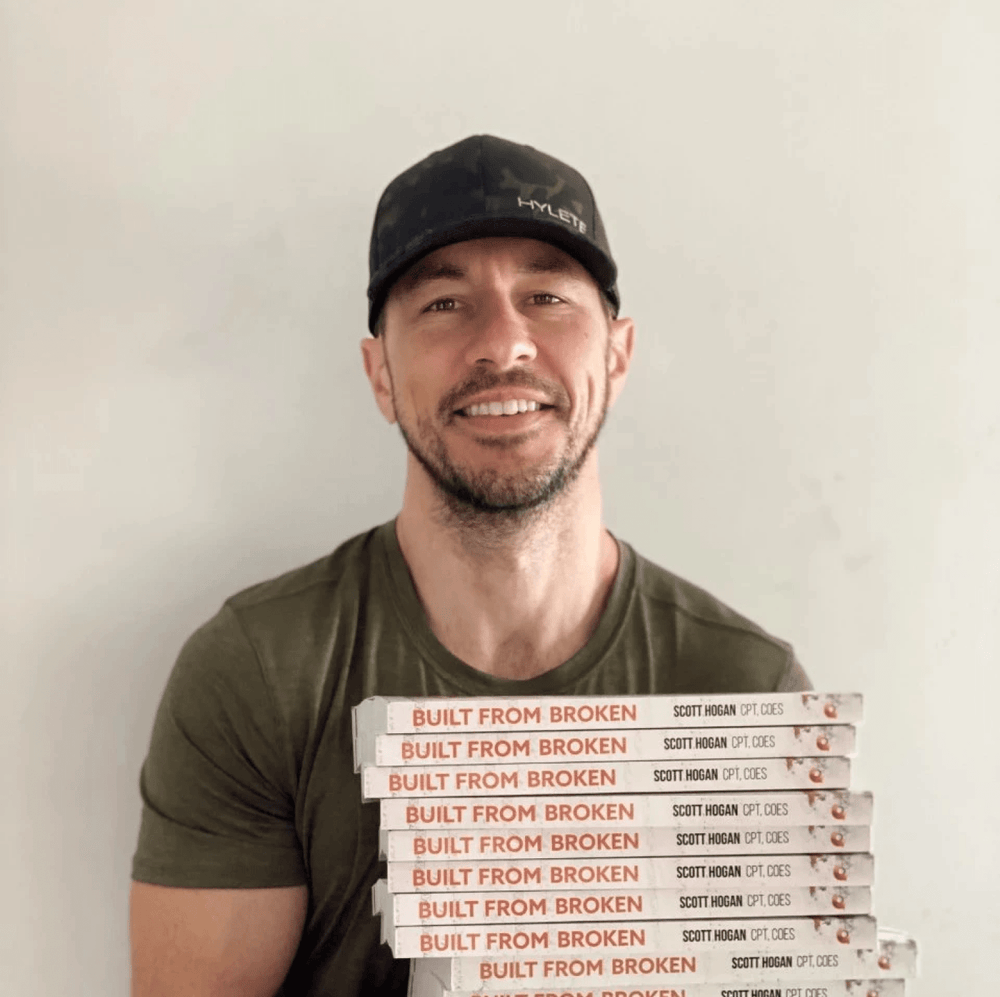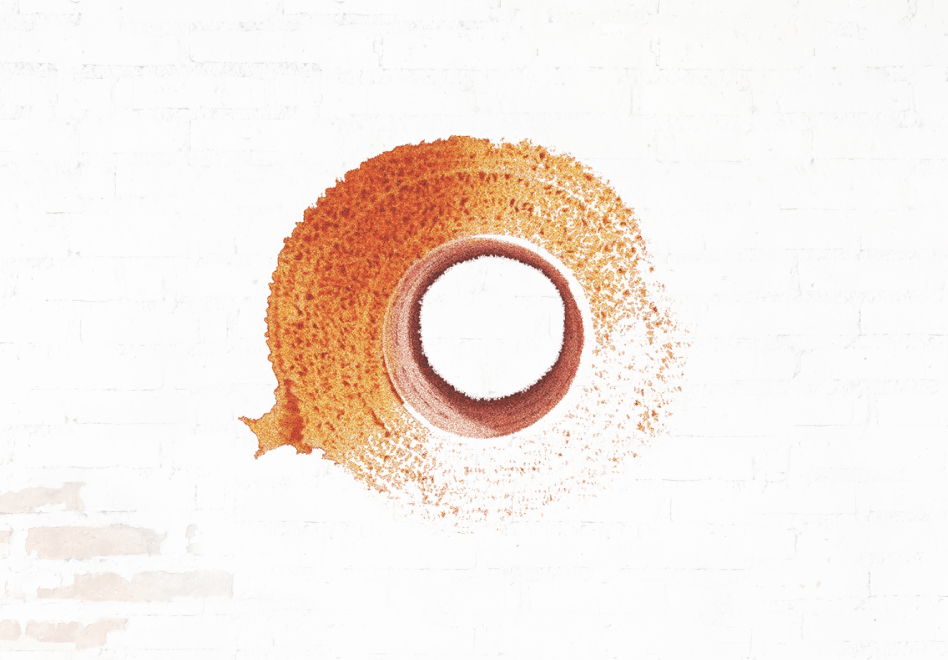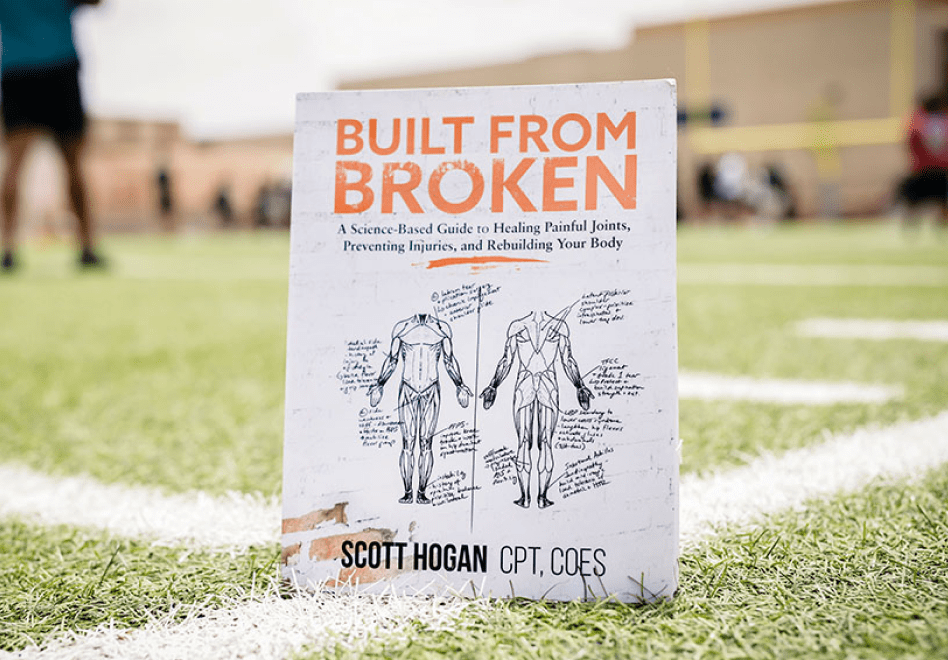
Be built (to last).
The right supplements can help you recover naturally and build a resilient body.

Supplement Quiz
Take this short quiz to discover the perfect supplements for your needs and goals.
About SaltWrap

Built from Broken
Get the best-selling book from SaltWrap founder, Scott Hogan, and start rebuilding today.
The Dichotomy of Fitness: How to Balance Goal Achievement, Injury Prevention, and Longevity
by Scott Hogan, ACE-CPT, COES
One of the things about being a small business owner that I struggle with most is the constant tug of war between having a long-term, marathon mindset — and having urgency to get things done.
Keeping these two opposing ideas in balance is gut-wrenching.
They’re not necessarily mutually exclusive. But it can sure feel that way.
I like the way Jocko Willink frames up opposing ideas like this.
In this best-selling leadership book, The Dichotomy of Leadership, he talks about a constant balancing act that true leaders must perform.
Being in command, but also empowering the team.
Being firm, but not overbearing.
Disciplined, but also adaptive.
Sticking to a plan, but being able to improvise when necessary.
While many of these concepts seem like polar opposites, they’re actually two sides of the same coin.
Interrelated, though different.
I find this a useful framework for thinking about fitness, injuries, and health in general.
Because going to an extreme is almost never the answer.
While striving for perfect balance is a fool’s errand, embracing the continuous counterbalancing act that’s required for real progress is a powerful thing.

For those of us who are balancing health, longevity, and fitness progress — it really hits home.
At times it can seem like fitness is full of trade-offs.
Sacrifice quality of life so you can lose weight.
Or sacrifice joint health so you can get stronger.
But just like in leadership, these differences start melting away when you think about them from a higher perspective. A long-term perspective.
You realize they aren’t opposing forces.
But two sides of the same coin.
Here are 4 mental models that are helpful for counterbalancing your goals while avoiding injuries, staying sane, and getting the most out of your body and mind.
1. Stop Fighting Your Physiology vs. Addressing Weaknesses
"You'll be huge."
A massive, late-50's powerlifter was pumping me up.
He had just demonstrated how to perform a sumo deadlift, after watching awkward 17-year-old me attempt a traditional deadlift.
He was clearly worried about me injuring myself.
I didn't have the hip mobility or core strength to safely perform the exercise.
The sumo deadlift is a variation that uses a wider stance and more upright posture.
Generally, it's easier on the lower back. And a popular option with people who've experienced a low back injury or lack flexibility.
It also gets flack from traditionalists, who say it's not a "real deadlift."
But here was this guy — clearly he had some experience picking up heavy weights — and he was telling me the sumo deadlift would be ideal for my body type (long-limbed and lanky).
I was confused.
"Shouldn't I learn the conventional deadlift?" I asked.
"Nah, don't fight your physiology on this one. Just do the sumo. Load up the bar and get after it. You'll be huge."
So I listened. Focused on improving my sumo deadlift. And eventually graduated to a narrower stance, executing a more traditional deadlift.
Which I credit with helping resolve my lower back pain and improving strength through my whole body. With noticeable translation into the sports I was playing at the time.
It was a formative experience. I had basically worked around a problem.
Avoided addressing a weakness. And it worked.
It got me started. And helped novice-me avoid certain injury.
On the flipside, it actually did address my weakness, though indirectly.
It allowed me to develop the necessary coordination and stability I needed to advance.
That example illustrates the dissolving gray area of these two-sided coins.
What initially seems like either “working around a problem” OR “addressing a weakness” is actually both. And neither at the same time.
Even still, some weaknesses should be addressed head-on.
For example, if you have tights shoulders and terrible posture, you should work on those things. They have cascading negative effects on your movement and overall health. And they don’t get better on their own.
But how much of your time and energy should be dedicated to resolving these kinds of weaknesses?
And how much time should be dedicated to performing safe, effective exercises that you can do right now without risking injury?
Tough questions.
After all, there's quite a bit that my shoulders still can't do.
I can't perform a barbell snatch, for example. An Olympic lift that involves picking up a barbell off the floor and pulling it upward, then “catching it” in an extended overhead position.
If I was a CrossFit athlete, I'd have to address it. Because it’s a common movement in the sport.
But I’m not. So should I care?
Maybe. Because it illustrates flexibility and strength problems.
Maybe not. Because there isn’t a good reason for me to care. It doesn’t align with what I’m trying to accomplish. Not to mention, it’s an inherently risky exercise.
So how do we know when it makes sense to stop fighting our physiology and move on, and when we should address the weakness (even if it means taking a step backward)?
Tim Ferriss makes a great case for leveraging our strengths:
“It’s far more lucrative and fun to leverage your strengths instead of attempting to fix all the chinks in your armor.”
But Arnold believes in attacking weaknesses. Turning them into strengths.
A good argument can be made for both sides.
But as far as I can tell, the main focus should be on establishing a baseline level of competence that prevents injury, enables longevity, and allows you to do what you want to do.
If you love to compete in obstacle course races, but you’re prone to shin splints, you don’t have to quit your passion to focus exclusively on yoga and shin rehabilitation.
Instead, do what you have to in order to get back to baseline.
From there, split your time between doing what you love (or doing what creates progress) and addressing your weaknesses.
The amount of attention you give each depends on an infinite number of personal factors. Which only you will know.
One of the key factors is how much influence you have over the weakness.
If we’re talking about a physiological characteristic, like flat feet, then there is only so much you can do to compensate for that.
If it’s a skill based movement. Or a soft-tissue problem like muscle tightness, then you have greater influence. And it deserves more attention.
The key is to not get locked up with dogmatic thinking.
And remember why you’re doing all this in the first place.

coun·ter·bal·ance (noun): a weight that balances another weight.
2. Pushing Through Discomfort vs. Recognizing a Problem
I’m the poster boy for this one.
As I’ve gotten older, I think a lot more about injury prevention. Staying healthy.
Mostly because I realize that if I injure myself and lose 6 weeks of training time, my progress will be shot to hell.
It won’t have mattered that I pushed out a few more repetitions on some exercise.
Any gains from overreaching will be totally lost.
At the same time, you can’t just leave the gym or go home anytime you feel a twinge in a joint. You’d never get anything done.
And older athletes will tell you that you’ll never be completely pain-free.
Discomfort is part of the deal.
Especially as we age.
But how do you know when to push through discomfort, and when to stop and recognize a problem (i.e. injury)?
Training experience is the most important factor.
Experienced athletes know their bodies.
They can tell the difference between a healthy muscle “burn” feeling, and a strain.
Soreness from tendinitis.
But the lines between all these sensations is thin.
So you have to be careful.
Again, there’s no easy answer here.
But usually, healthy discomfort — be it the burning in your chest when running sprints or pain in your legs when performing a high-rep set of squats — subsides when you take your foot off the gas.
It may not go away completely, but it lets up.
So if you notice something that doesn’t feel good while you’re working out or doing any intense physical activity, take a short pause.
See if it lets up a bit. If it does, that’s a good sign.
And in the case of an annoying hip pinch, shoulder twinge, or stiffness in your lower back — these little ailments tend to loosen up with activity.
If you can start slow and work your way up to full function without causing a major flair up, then you’re in good shape.
But if the pain doesn’t let up after warming-up thoroughly, it’s time to give it some respect.
You may have a problem that needs addressed.
[See Related: How to tell if an injury is serious]
Ideally, you’ll prevent this from happening in the first place.
And one of the best strategies for doing that (while also making substantial progress) is balancing your strategic side with your intense side.
3. The Intellectual vs. The Beast
I’d say about 40% of the time I injure myself, I’m doing something that the little voice in the back of my head warned against.
Jiminy Cricket told me it was stupid, and I did it anyway.
10% of the time I have no clue what happened. Until I analyze it later.
Some injuries just come out of the blue.
And the final 50% of my personal injuries come when I’ve completely shut off higher thinking.
Either because I’m jamming along to music that has me spaced out… my head is in the clouds, not attentive to what I’m doing… or I just let the moment get the best of me.
The solution for this last 50% is to balance your intelligent, strategic mind (the Intellectual) with …your wild side.
The Beast, if you will.
The intense part of your self that comes out when you’re reeeeally letting some aggression out. Or pushing your body to its breaking point, just to see how far you can go.
This type of intensity is necessary to perform at a high level.
And it’s a trait that virtually every athlete, weight lifter, or performer who has accomplished greatness has in spades.
There isn’t a championship fighter on this planet who reached the top of his field by just being smart and training intelligently. There’s a wild animal in there.
The same can be said for virtually any sport. Or any competition that requires personal sacrifice and enduring pain.
But letting The Beast out has its drawbacks.
Because The Beast tends to be stupid.
The Beast doesn’t think very deeply about things.
Picture that guy at your gym.. (you know the one).
Headphones on with ear-splitting death metal music playing.
Hat pulled down low over his eyes.
A hooded sweatshirt with the sleeves cut off, which I can only assume serves the same purpose as putting blinders on a mule; so he won’t get distracted by anything in his peripheral.
He’s bouncing around. Grunting. Smashing weights and having a hell of a time.
Eking out every last drop of work in his muscles.
That guy gets injured a lot.
Unless he’s just genetically gifted with bulletproof joints.
But usually, taking this approach doesn’t end well.
So how can we let the beast out, so to speak, without getting full on stupid and hurting ourselves?
I like to think of this strategy as splitting your psyche in half.
Like everything, experience builds an intuitive feel for when you can push harder, and when its time to back off.
But in this case — it helps to consciously split your self in half: The Intellectual, and The Beast.
Summon The Intellectual when its time to plan your workouts.
Before entering the gym or hitting the track. Never start training without a clear plan.
Think hard about what your goals are.
What your body can handle.
The exercises that combine massive upside with low downside (low risk of injury).
Detail out, in writing, exactly what you plan to do for that training session. Make it clear. Specific.
Then, shut The Intellectual down.
You don’t want The Intellectual judging every move.
You won’t get anything done that way.
Instead, go into “beast mode” once its time to train.
Trust in the fact that your smartest, nerdiest, most injury-leery self planned this workout for you.
Stick to the program, and within the parameters of the that program, push yourself as hard as you can.
If there’s still room in the tank at the end of your training session, its time to go back to the drawing board. Make a better plan for next time.
If you bit off more than you can chew, then reduce the volume of work at the next session.
Over time, these two halves of your self will start to step in sync.
They’ll understand each other.
This mindset allows you to challenge yourself while also playing it relatively safe.
4. Urgency vs. Marathon Mindset
What’s more important..
setting goals, or following an effective system?
Most people lean toward goal setting.
We romanticize the whole “shoot for the stars” thing.
We’re drawn to sayings like “dream big” and improbable success stories of our heroes who started with a near-impossible vision of their future before eventually conquering their world.
But the truth is, process is king.
Ideally, you’ll have both.
A clear, specific goal that aligns with your values.
And an effective, incremental process that IF FOLLOWED will move you toward the goal.
But if you have to pick one, pick process.
As productivity author James Clear notes, “goals are good for planning your progress and systems are good for actually making progress.”
I don’t know about you, but I’d rather make progress than just plan for it.
Now, if you back up a bit.
And shift the focus to how you feel about the whole thing, it gets interesting.
Studies clearly show that writing down goals improves outcomes.
[See Related: The daily fitness planner for goal tracking and fitness measurement]
And many experts agree that focusing on the process — which involves often boring, repetitive, deliberate practice — is the real key to success.
But what about your mindset…how you feel about your goals, vision and process?
Should you have urgency? Or a marathon mindset?
Author and entrepreneur Michael Simmons believes firmly in the marathon mindset.
Which means thinking of your goal in long time ranges.
As a race that is won over months and years, not in a single day.
Many of history's greatest thinkers, athletes, and leaders shared this trait.
They were able to put off what they wanted in the moment to achieve what they wanted far in the future.
They were patient.
They understood that greatness is a process that takes years.
A lifetime, in many cases.
But as any competitor or business person will tell you — having urgency is a crucial part of the equation.
If you just sit back and say “oh my business will be profitable down the road,” you’ll end up in the gutter.
If an athlete says “I’m focused on a career with longevity” she’ll lose sight of the battle that’s right in front of her. Which could derail the career too.
I’m reminded, here, of my favorite (anti-anxiety) quote. It’s one I have written down in multiple places. Including my computer screensaver:
"Our main business is not to see what lies dimly at a distance, but to do what lies clearly at hand."
- Thomas Carlyle
If you take that too literally, or think too shallow about it, it sounds a lot like:
“live in the moment dude! You never know.. the world could end tomorrow..!”
To be clear, that’s not how I take it.
To me, this quote is best served to an individual who thinks long-term.
Always three steps ahead.
For better or for worse, they think about their future. Plan for it. Save for it.
And maybe even get caught thinking about it too much..
"Life passes most people by while they're making grand plans for it."
- character of George Jung, Blow
This type of person needs reminded to focus on today.
On what’s right in front of them.
In the fitness world, that means having a vision and doing the best job you can today to move closer to that vision.
But it all starts with developing a clear goal that you can point your mind toward.
Then working backward.. figuring out what it will take to get there.
What kind of process you’d need to implement.
The routines, rituals and environment you would need to follow that process.
Then.. and only then.. once all that is in place… you put your head down, and go to work.
You break the process up into bite size chunks.
And you deliberately address each, one at a time.
Not with desperation. But with calm, focused energy.
Knowing that you’ve put in the “thinking” work.
You have a long-term, marathon mindset.
You understand that nothing is ever finished, and that you’ll always be striving.
But also, that right now — it’s time to put your nose to the grindstone and work.
If you do this, you can go to work with a clear mind.
Because you know that you are going in the exact direction you’re supposed to be going.
If you can master this double-side coin, the world is your oyster.
And please, if you do, let me in on your secret.
How to Use Adaptogens for Balanced Energy
The concept of balance is a recurring theme for us at SaltWrap.
In the spirit of balance and longevity, we wanted to develop a way to improve energy, health and overall effectiveness without depending on artificial stimulants.
We wanted a sustainable method for optimizing mind and body.
A productivity booster that doesn't leave your adrenal system drained and your mind twitching with anxiety.
This idea led to the development of Adaptogen Greens.
Adaptogen Greens is a 4-in-1 complex of adaptogenic herbs.
Adaptogens are a unique class of nutrient.
They work much like a thermostat.
When the thermostat senses that the temperature in a house is too high, it guides the temperature down to the set point.
And, when the temperature is too low, the thermostat helps bring it back up to where it should be.
This is the same function that adaptogens have in the human body.
They help bring our body and minds into balance — adjusting energy hormones, stress hormones, and even neurotransmitters up or down based on what we need.
They are rightly named adaptogens because they exhibit a normalizing effect on the body, helping to correct physiological imbalances.
They quite literally adapt their function according to the body's specific needs.
Adaptogen Greens combines four research-backed adaptogens into one formula.
Giving you a new tool for boosting energy and focus while also effectively managing stress levels.
This is my goto for stress-free, stimulant-free productivity.
So if you're looking for a boost without all the side effects and jitters, check it out.

Conclusion
It's tough to take a hard stance on these approaches to fitness, one way or another.
But that's OK.
The point isn't to have all the answers.
It's to be cognizant of the questions.
Perfect balance doesn't exist.
Trying to achieve it will waste your time at best, and drive you absolutely crazy at worst.
It's fashionable to talk about how "balance" doesn't exist.
In our personal lives, careers, relationships.
But it's just as important to talk about the need for active counterbalancing.
You may never achieve perfect balance, but that doesn't mean that the pursuit of better balance isn't important.
Especially for people like me, who have a tendency to go to extremes.
Advising me to just forget about balance altogether would be dangerous.
I'd end up broken. Mentally and physically.
On the other hand, someone who is more conservative might be better served with a gentle push — by being told to go ahead and lean into the extreme.
It's all individual. It depends on who you are and what you are trying to accomplish.
But one thing is for certain. Being aware of these double-sided coins is powerful.
And dedicating thought and energy into counterbalancing them is the best way to ensure progress today, and longevity tomorrow.
Founder: Scott Hogan

I created SaltWrap to bring together the most practical ideas in therapeutic sports nutrition, corrective exercise, and functional fitness — with the goal of keeping you (and myself) strong, mobile, and built to last.
I've worked as an A.C.E. Certified Personal Trainer, Orthopedic Exercise Specialist, and nutritional supplement formulator.
But more importantly — I've spent most of my life battling injuries, joint pain, and just being plain beat up. So I know what it's like to struggle toward fitness goals.
SaltWrap is here to push you through injuries, setbacks and perceived physical limitations. To a place beyond what you think you're capable of. Sign up here to stay in the loop.
Learn more about my best-selling injury prevention and recovery book, Built from Broken.







